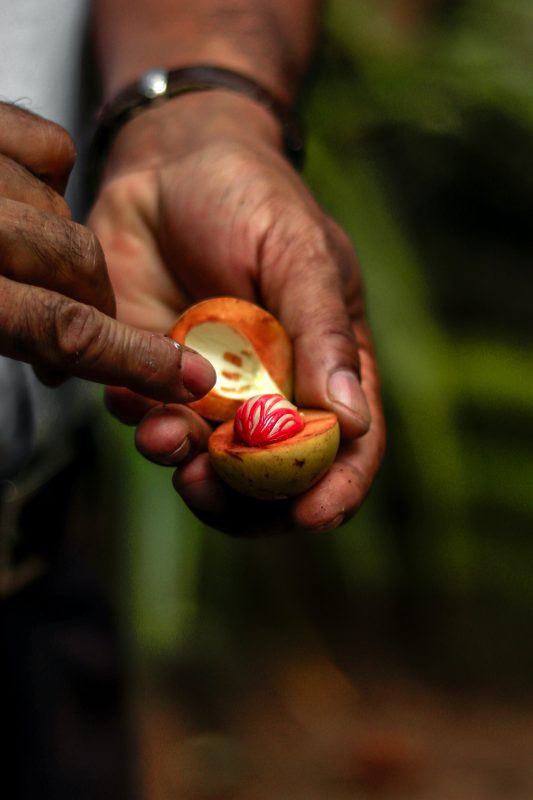Nutmeg is the seed or the ground spice created by grinding the seeds of several species of the genus of Myristica. Typically, Myristica fragrans, which are also known as true nutmeg or fragrant nutmeg, are used for the purpose. Nutmeg is produced from an evergreen tree with dark leaves which is cultivated for the two spices it produces – mace, from its seed coverings, and nutmeg, from its seeds.

Nutmeg Applications as a Spice
Nutmeg, as a spice, has a distinctive pungent odor, accompanied by a warm and slightly sweet taste. It gets used in the food industry and household cooking to offer flavor to various baked products, potatoes, meat dishes, puddings, and sausages. It also works with vegetables, confections, sauces, and beverages such as eggnog.
It adds flavor to numerous dishes, primarily in several spicy soups in Indonesian cuisine. These include sup iga (ribs soup), sup kambing, and oxtail soup. It can be in the gravy of meat gastronomy like ribs with tomato, semur beet stew, and dishes such as rolade (minced meat roll), bistik (beefsteak), and bistik lidah (beef tongue steak).
In Indian cuisine, nutmeg gets used in the preparation of sweet and savory dishes. In the Malabar region of Kerala, grated nutmeg enhances the taste and aroma when used during meat preparation. It also works wonders in the all-around spice mixture of the country, garam masala.
In traditional European cuisine, chefs predominately use nutmeg in potato dishes, baked goods, soups, and processed meat items and products. An exceedingly common application of the spice is in rice pudding.
In Dutch cuisine, the spice gets added to cauliflower, Brussel sprouts, and string beans. It improves the flavor of the bland-tasting vegetables. It is also a traditional ingredient in cider and mulled wine.
In Italian cuisine, individuals use nutmeg in the stuffing of several regional meat-filled dumplings and meatloaf. It’s also in pumpkin pies, tortellini, and winter squashes like those with acorns.
In Scotland, nutmeg gets used as an ingredient in haggis. It gets sprinkled on the top of drinks like Painkiller, Bushwacker, and Barbados rum punch in the Caribbean.
Nutmeg Benefits
Nutmeg, when consumed in recommended amounts, has a colossal number of advantages associated with it. A few of them include:
- Antioxidant properties: Nutmeg has a high antioxidant level. Therefore, it protects the body from cellular damage, carcinogenic ailments, heart diseases, arthritis, stroke, cancer, Parkinson’s disease, and so on. It also slows down the aging process to some extent.
- Anti-inflammatory properties: Nutmeg can reduce chronic inflammations by inhibiting the enzymes that promote them. Hence, it can protect the body from associated health conditions like joint swellings. Nutmeg has several essential volatile oils that help reduce pain. They include elemicin, myristicin, safrole, and eugenol present.
- Relieving effects on the body: In smaller doses, nutmeg has a calming, sleep-inducing, and de-stressing effect. Thus, individuals use it to treat insomnia and digestive issues like bloating or gas formation, diarrhea, and constipation.
- Improves brain health: Nutmeg works as an aphrodisiac, having stimulating effects on the cranial nerves. It acts as an effective ingredient in anxiety and depression treatment by relieving stress and fatigue. It can lift moods and enhance concentration.
- Antibacterial properties: Nutmeg has strong antibacterial properties that work effectively to cure bacterial infections. It helps remove the microbes from inside the mouth, relieve toothaches, and curbs numerous oral health issues.
- Blood Pressure: Due to its high mineral content that includes iron, calcium, manganese, potassium, and so on, nutmeg works wonders in blood regulation and circulation. By reducing the pressure exerted on the heart, it prevents heart diseases.
Harvest Area and Nutmeg Season
The Nutmeg tree, Myristica fragrans, is indigenous to the Moluccas or Spice Islands of Indonesia. It thrives well in warm and humid conditions and locations that receive more than 150 cm. of rainfall. The model altitude for the proper growth of nutmeg is about 1300 m. above mean sea level. Nutmeg trees prefer to grow in areas with sandy loam, red laterite, and clay loam soils.
From the sixth year of its plantation, the female nutmeg trees start the fruiting process. Overall, the peak period of this development is when the plant reaches 20 years. After the fruit initiation, the fruits become ready for harvest in about nine months after flowering, making the ideal harvesting season during June-August when the pericarp of the ripe fruits split open.
Contact us for discussing supplying Nutmeg and Mace in bulk from here
